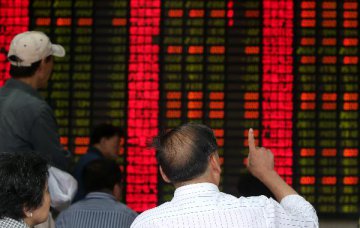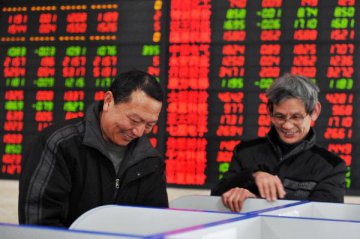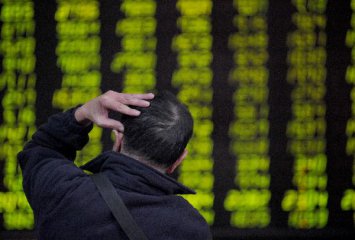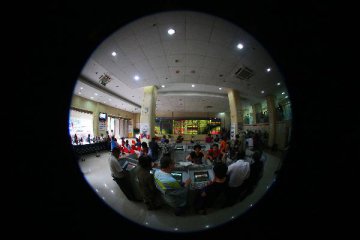
The continuous surge in the European stock market finally shocked the A-share market in China this week. The A shares went higher yesterday, easing investors’ nervous tension during the Chinese New Year. Most of individual shares hiked, and the increase led by blue-chip securities brokerages and the continuous rebound in the ChiNext Board facilitated long positions.
Will the market experience a short-term adjustment or continue to recover after climbing quickly in a short period? Are there any other factors preventing A shares from rebounding?
Factor 1: overseas stock market
The global stock market suffered violent fluctuations during the Chinese New Year. Prices of risky assets plunged and safe-haven assets including gold were favored, which caused investors worrying the trend of A shares after the Spring Festival. However, the slumping trend of foreign stock market have turned around since last Friday (Feb. 12), relieving the pressures on A shares.
Due to the favorable news from the overseas market, the Hang Seng Index (HSI) opened higher and went higher and the gain narrowed in the afternoon of yesterday. By closing hours, it rose by 1.08 percent to end at 19,122.08 points. Shanghai-Hong Kong Stock Connect saw net buying for two consecutive days with a net buying worth 532 million yuan and 456 million yuan in Northbound Trading and Southbound Trading respectively. There was 10,044 million yuan remaining for the quota and the balance accounted for 96 percent of the quota.
A research report of Essence Securities believes that there are two logics which can explain the abnormal drop of A shares against the market trend resulting from the declining global risky assets. Firstly, in terms of fundamentals, the direct cause leading to the plunge in the global stock market was the profitability and bad debts of the banking stocks, which resulted in investors’ worry over global crisis and a large number of risky assets was undersold. But as for the relatively closed system in China, the situation that the overseas investors concern about is unlikely to occur in economic field or banking filed.
Secondly, in terms of emotional factors, since the international risky assets fell, investors were inclined to avoid risks. Therefore, domestic risky assets were unlikely to be immune from the situation. The fact that the A shares opened lower or suffered decrease against market trend for one or two days is acceptable, but there is no need to be too pessimistic about the potential fall. As the world’s liquidity maintains loose, substantial shareholders of A shares decreased their shareholding and issues concerning exchange rate are worked out in a short term, investors continue to believe that the A shares will experience an oversold bounce during February when the two sessions take place.
Factor 2: bulk commodity
International oil prices began to dive from the peak. Prices of Brent crude oil and crude oil traded on New York Mercantile Exchange (NYME) shrank by more than 5 percentage points. Analysts thought that at the just-concluded Doha meeting, oil-producers, including Katar, Saudi Arabia, Russia and Venezuela, agreed to keep the output unchanged, while the market expect them to reduce the output.
At 17:15 (Beijing time), major contracts of crude oil futures traded on the NYME closed at 32.25 U.S. dollars per barrel, up by 1.07 percent. Its highest price hit 33.78 U.S. dollars per barrel, representing an increase of about 5.86 percent. Major contracts of Brent crude oil settled at 34.08 U.S. dollars per barrel, up by 0.21 percent. Its highest price recorded 35.55 U.S. dollars a barrel, representing an increase of about 6.47 percent.
Factor 3: liquidity
According to the situations from home and abroad, problems restraining liquidity at the stock market can be judged as optimistic in the short run.
Concerning the foreign market, the liquidity of overseas market continues to see improvement and provides loose space for domestic monetary policy. The monetary policy of major central banks in the world continues to carry out zero interest rate or negative interest rate. The market expects that the European Central Bank might cut interest rate again and the Federal Reserve may fail to hike interest rate in March. The strong Japanese yen raises the expectation on Japanese central bank’s intervention.
In terms of domestic situation, the weakening industrial economy, deflation pressure and the high local government debts are the reasons for the objective demand for loose monetary policy. Moreover, as the U.S. economic performance was worse than expectation and the U.S. assets became less attractive when the risks of U.S. stocks were exposed, the pressure of Chinese capital outflow reduced.
Factor 4: exchange rate
Before the end of Spring Festival, China’s central bank governor Zhou Xiaochuan revealed policy orientation of China’s central bank in an exclusive interview.
CNY and CNH rates both broke through 6.50 on the first trading day after the holiday. So far, Chinese yuan has gained “eight consecutive increases” in the onshore market during the Spring Festival, setting a largest growth rate in ten years. Although there is a fallback today, exchange rate of Chinese yuan will rise in a short term under the background of periodical weakness of U.S. dollar. The central bank also holds a more cautious attitude, stressing that it will focus on policies’ overflow effect on financial market, take proper paces to carry out exchange rate reform, and pay more attention to relationship between each market and global economic and financial trend.
“Crash in both stock market and foreign exchange” in January has impressed us up to now, and restriction of exchange rate trend becomes crucial to influence A-share trend.
Changes in overseas market during the holiday are not exactly bad news to A shares, stated by the latest strategy weekly of Guosen Securities (002736.SZ). Previously, an obvious restriction on A shares is that, after the U.S. entered a stage to raise the interest rates, pressure from stabilizing exchange rate made the central bank partially give up independence of monetary policies, which compressed the easing space of monetary policies, and the market expectation on future liquidity sharply worsened under the depreciation pressure of Chinese yuan.
However, along with the weakening U.S. data and worsening overseas market fluctuation, the Fed has to delay the time-point of raising interest rates, and U.S. dollar index begins to suffer a downtrend. Exchange rate of Chinese yuan against the U.S. dollar even rose to some extent in the offshore market during the holiday, and liquidity pressure triggered by the exchange rate eased somewhat. Additionally, measures related to supply side reform are likely to issue one by one, forming positive force to push the market. Therefore, it faces short-term fallback, but some positive factors could still support the following market, and investors should not be over panic.
Factor 5: incremental capital
The market now feels rather awkward that incremental capital is still not that willing to enter the market. Investors with comparative benefits need to constantly adjust the positions to push the market vitality, but those pursuing for absolute gains are very reluctant to greatly increase the positions before they see a clear signal. In terms of medium and long term market trend, a cautious attitude is still required.
On the other side, latest data shows that 262,300 investors were newly added in the Shanghai and Shenzhen bourses during the last week (Feb 1 to 5) before the Spring Festival, down by 26.09 percent when compared to that of last month, which had consecutively declined for two weeks.
Strategy for future market
Under the background that short-term fluctuation and consolidation have formed a bottom, various securities companies suggest the investors carry out defensive long measures and band operations, and they also recommend certain products, such as gold, supply side reform, those with favorable prosperity, over-dropped stocks and blue chips. Investors still need to wait for medium-term opportunities along with weak economy.
According to China Merchants Securities (600999.SH), declines in the overseas market will press A-share market risk preference under the weak market, but some main factors previously pressing the market will continue to improve in a short term.
Ren Zeping, chief macro analyst of Guotai Junan Securities (601211.SH), also pointed out that gradual stabilization of exchange rate of Chinese yuan can ease the global concern, and enhance the risk preference, which has been proved by successive soars of stock markets in Japan and Europe. Expectation on Chinese yuan becomes stable, and national policies released favorable news before the two sessions, making the market risk preference improve. The second round of adjustment has been basically finished for the A-share market.
Zhang Yidong, chief strategy analyst at Industrial Securities (601377.SH), stated that the market suffered an extreme crash in the middle and last period of January, and February is a chance to take a break. He expected that indexes are still likely to rebound for recovery, having experienced opening low in the first trading day after the Spring Festival, but with relatively-limited time and space, defensive and aggressive operations may be carried out in turns during the rebound, which possibly becomes a weak rebound with trade sideways.
According to the latest weekly strategy report of Ping An Securities, there is no need for the market to concern too much on A-share short-term trend, but the medium-term risk has not been effectively released. As black swan events have remarkably increased in the financial market since 2016, these factors have made the investors take more time to wait for medium-term opportunities in the market.
Referring to allocation, Guosen Securities suggests the market focus on three mainlines in the following:
1) Traditional leading enterprises related to gold and supply side reform;
2) Prosperous industries during the Spring Festival, such as film and tourism;
3) During disclosure period of annual and the first-quarter reports, some quality growth stocks begin to achieve investment value after declines, and investors may gradually pay attention to them.
Translated by Vanessa Chen & Jelly Yi























Latest comments